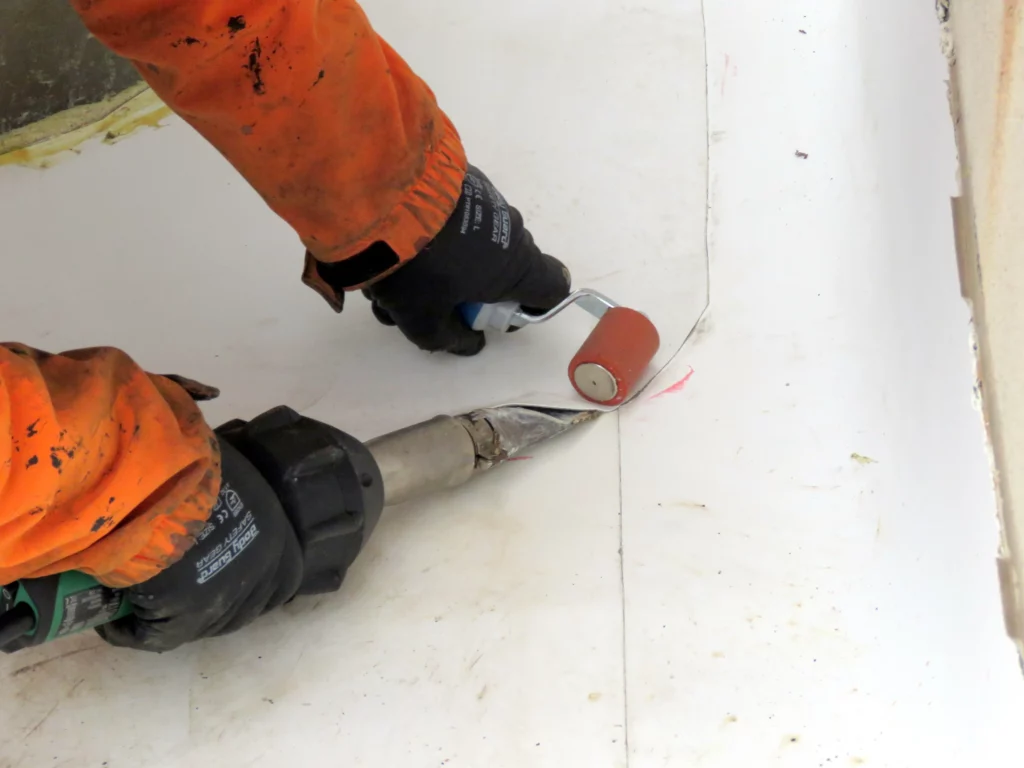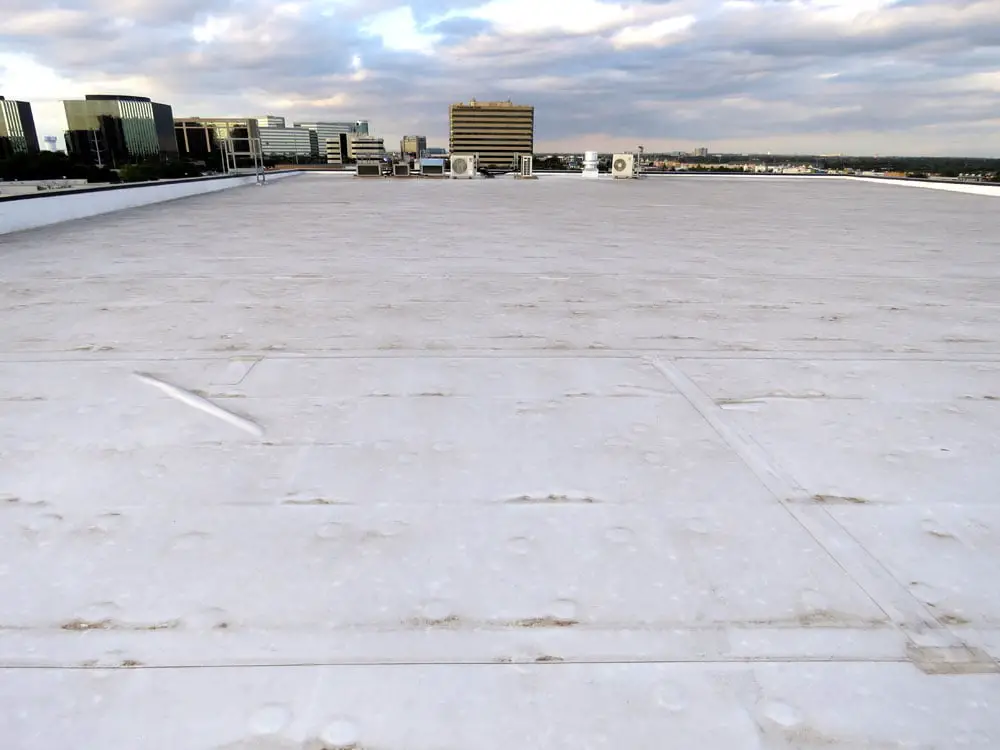TPO Roofing Cost Guide (2024) • By Membrane & System Type
By Jack Gray, Roof Online Editor • Updated December 31, 2023
To learn more about TPO roof systems, please see our Introduction to TPO Roofing.

Table of Contents
Introduction
As professional roof consultants, we have to produce accurate roof replacement budget projections for our clients every year. This means keeping up-to-date with changing material and labor costs for all kinds of roofing, including TPO roof systems.
In this article, I’m going to explain the factors that determine TPO roofing costs. I’ll also give you the typical costs for various types of TPO membrane roofs in 2024.
TPO roofing is typically considered commercial roofing, but homeowners can use it for residential roofing applications on flat roof areas as well.
Keep in mind that the cost of any particular TPO roof will depend on several variables, including roof size, roof complexity, local labor costs, membrane thickness, roof system attachment method, and insulation R-value requirements.
Whether or not a roof recover (putting the new roof over the old roof) is an option can have a huge effect on the cost of a roofing project.
On average, the cost of a new TPO roof in 2024 ranges from around $4 per square foot for a 45-mil ballasted TPO membrane installed over an existing roof to around $14 per square foot for the longest-lasting and best performing TPO roof, a fully-adhered 80-mil TPO membrane system (with insulation that meets R-30 R-value code requirements).
What is TPO Roofing?
TPO roofing is a type of single-ply roofing in which sheets of TPO membrane are joined together to form the waterproofing component of the roof. TPO stands for “thermoplastic polyolefin”; it is heat-weldable (that’s the thermoplastic part) and UV-resistant.
Thermoplastic polyolefin roof membranes are created by using extremely hot air to weld the edges of TPO sheets together to create a continuous waterproof barrier that covers the surface of the roof.
TPO membranes are most often white, but you can get TPO in white, tan, and gray as a standard product from almost all manufacturers. Other colors are available by special order.
The other components of a TPO roof assembly include the roof deck, which provides structural support, a vapor barrier above the deck (if needed), layers of rigid board insulation, and a cover board (or overlay board) under the membrane (as specified by the manufacturer). Attachment components such as adhesives, fasteners, or ballast are also an important part of the system.
The first time a “TPO-type” roofing product was used in the U.S. was around 1987. Large-scale promotion of TPO roofing products in the US began in the 1990s.
TPO is now the single most popular flat roof covering in the United States for new commercial roofing projects.
The use of reflective white membranes like TPO has been largely driven by energy code changes and LEED requirements demanding “cool roof” systems intended to reduce air conditioning loads and counteract the urban heat island effect.

TPO Roofing Costs in 2024
These cost estimates should be fairly accurate; we try to keep them reasonably up-to-date using current or recent material prices and labor data.
Keep in mind that the costs listed below are national averages, and costs can vary quite a bit according to location.
To get a more accurate idea of what a new TPO roof will cost in your area, see our article “Relative Construction Costs by U.S State” and apply your state multiplier to the national average cost.
Table 1: TPO Roofing Cost per Square Foot
The cost estimates given in the table below cover the installation of various types of TPO roof systems. All of them include the cost of the TPO membrane, the membrane attachment system, the appropriate cover board installed under the membrane, and the labor required for the installation.
1. The second column, showing current price estimates for the average installed cost per square foot with no additional insulation, is for the TPO membrane, the membrane attachment system, and the cover board.
This type of roof is appropriate when a new TPO roof is installed on top of an existing roof and no insulation R-value increase is required (a roof recover). It is also appropriate on roof areas where insulation is installed below the roof deck, or on roofs over unheated interior spaces, such as sheds or some garages.
2. The third and fourth columns provide price estimates for full roof systems including insulation that meets the code-required total system R-value. R-25 is the typical R-value requirement in the southern half of the U.S., and R-30 is common in the northern half of the country. Some places will have different roof R-value energy code requirements, so always check your local code.
Our calculations use prices for expanded polystyrene insulation boards in the ballasted systems, and prices for polyisocyanurate insulation boards in the other two systems. Ballasted systems do not normally include a separate cover board layer, so we did not include prices for cover board in the ballasted systems that also include insulation.
The estimates include the removal of the existing roof in the third and fourth columns and we have added $1.00 to $2.00 per square foot for that.
| Average Cost of a TPO Roof System per Square Foot by System Type |
|||
|---|---|---|---|
| Type of TPO Roof System | Average Installed Cost Per Square Foot No Insulation |
Average Installed Cost Per Square Foot Insulation R-25 |
Average Installed Cost Per Square Foot Insulation R-30 |
| Ballasted TPO Roof 45-mil Membrane |
$3.95 | $8.95 | $9.95 |
| Ballasted TPO Roof 60-mil Membrane |
$4.35 | $9.35 | $10.35 |
| Ballasted TPO Roof 80-mil Membrane |
$4.70 | $9.70 | $10.70 |
| Mechanically-Attached TPO Roof 45-mil Membrane |
$4.45 | $11.45 | $12.95 |
| Mechanically-Attached TPO Roof 60-mil Membrane |
$4.85 | $11.85 | $13.35 |
| Mechanically-Attached TPO Roof 80-mil Membrane |
$5.15 | $12.15 | $13.65 |
| Fully-Adhered TPO Roof 45-mil Membrane |
$4.70 | $11.70 | $13.20 |
| Fully-Adhered TPO Roof 60-mil Membrane |
$5.10 | $12.10 | $13.60 |
| Fully-Adhered TPO Roof 80-mil Membrane |
$5.45 | $12.45 | $13.95 |
Table 2: TPO Roofing Cost by Roof Size
The cost estimates given in the table below are for commercial roof replacement, including roof tear-off (removing the existing roofing down to the deck), and installing a new TPO roof system using 60-mil TPO membrane (the most commonly used membrane thickness), as well as the 4 to 6 inches of insulation required to achieve an R-25 roof system R-value.
Installing a new roof system over an existing roof (roof recover) should not normally (by code) require adding insulation and can result in a large reduction in material and labor costs.
Roof recover (also known as a roof overlay) is only an option if there is just one existing roof in place, and it may not be desirable for a particular roof for any number of reasons. A roof recover typically has a useful life expectancy that is about 25% shorter than full roof replacement systems.
Although the numbers given below reflect constant prices per square foot as the roof sizes increase, you may actually see small per square foot cost reductions for bigger roofs, possibly up to around 5% or a little more for the biggest roofs. It’s important to get competing bids from at least 4 or 5 roofing contractors to get the best price.
We recommend that you hire a credentialed professional roof consultant before undertaking a roof project that costs more than $50,000 rather than leaving the details of your project up to a roofing contractor. A good roof consultant may even figure out how to re-use the existing insulation and save you a lot of money on your roof replacement.
| Cost of a TPO Roof System by Roof Size | |||
|---|---|---|---|
| Roof Area | Average Installed Cost 60-mil TPO Membrane Ballasted System |
Average Installed Cost 60-mil TPO Membrane Fully-Adhered System |
Average Installed Cost 60-mil TPO Membrane Mechanically-Attached System |
| 500 Square Feet | $4,675 | $6,050 | $5,925 |
| 750 SF | $7,013 | $9,075 | $8,888 |
| 1000 SF | $9,350 | $12,100 | $11,850 |
| 1250 SF | $11,688 | $15,125 | $14,813 |
| 1500 SF | $14,025 | $18,150 | $17,775 |
| 2000 SF | $18,700 | $24,200 | $23,700 |
| 5000 SF | $46,750 | $60,500 | $59,250 |
| 10,000 SF | $93,500 | $121,000 | $118,500 |
| 25,000 SF | $233,750 | $302,500 | $296,250 |
| 50,000 SF | $467,500 | $605,000 | $592,500 |
| 100,000 SF | $935,000 | $1,210,000 | $1,185,000 |
| 150,000 SF | $1,402,500 | $1,815,000 | $1,777,500 |
| 200,000 SF | $1,870,000 | $2,420,000 | $2,370,000 |
| 500,000 SF | $4,675,000 | $6,050,000 | $5,925,000 |
TPO Roofing Cost Factors
The two biggest cost factors are labor and materials. For a TPO roof, this typically breaks down to roughly 25% to 40% for labor and 60% to 75% for materials.
Material Costs
Material costs for a TPO roof are determined by the size of the roof, the membrane thickness, the attachment method of the system, and especially on the amount and type of insulation required to meet energy code requirements.
Labor Costs
In terms of local labor costs, you can expect to pay more if you live in an area with a higher cost of living. States where commercial roofing is typically performed by union roofers tend to have higher labor costs generally.
Roof Complexity
The complexity of the roof is a big factor in the labor costs for a TPO roof installation.
If a roof has a lot of rooftop equipment, skylights, or other penetrations, these things will slow the work down as time is needed to cut the insulation to fit the penetration and then install the flashings properly.
It can take twice as long (or longer) to install a square of roofing in a complicated roof area than in a simple area where you just have to lay the insulation and membrane down.
Removal of Existing Roofing
It isn’t always required by code, but it’s usually a good idea to remove any existing roofing materials before installing a new roof. This will increase the cost of the job, but it will help ensure a much better quality result.
With very high insulation R-value requirements, improved performance may be outweighed by the significant cost savings a roof recover (or overlay) can give you.
Roofs installed over an existing roof tend to leak more often and don’t typically last as long as a new roof built from the deck up.
Of course, a roof recover may not be an option. If you already have two layers of existing roofs on your building, the building code requires removal down to the deck before installing a new roof. You can’t have three layers of roof in place.
Removal and disposal of the old roof material will normally add around $1 to $2 per square foot to the total price of the job, but it can cost more in some areas.
Local Taxes, Fees, and Permits
Varying building permit fees, dumpster rental fees, disposal fees and/or local taxes may apply to your roofing job and should be factored into the total cost.
TPO Membrane Thickness
Individual sheets of TPO membrane come in rolls in a variety of widths and lengths. 10 ft. x 100 ft. is a typical sheet size for large ballasted and fully-adhered roof installations, while 6 ft. x 100 ft. is more common with mechanically-attached systems.
TPO membranes are manufactured with a reinforcing polyester scrim sandwiched between two layers of TPO to improve the strength of the membrane.
Standard TPO membrane thicknesses are 45-mil (0.045 inches or 1.14 mm), 60-mil (0.060 inches or 1.52 mm), and 80-mil (0.080 inches or 2.03 mm).
Thicker TPO membranes typically last longer and perform better than thinner membranes, all else being equal. (They will also cost more per square foot.)
Types of TPO Roof Systems
Ballasted Systems
“Ballasted” refers to an attachment system in which all of the layers of the roof system are loose-laid, without using any fasteners or adhesives to secure the membrane or the insulation, with river-washed stones or pavers installed on top of the membrane.
Ballasted systems depend on the weight of the ballast stone (typically 10 to 20 pounds per square foot) to hold the entire roof system in place.
Ballasted TPO systems are relatively uncommon. A major selling-point of TPO is that it’s normally white and highly reflective and qualifies as a cool roof system. If you cover the whole thing with ballast, you lose this benefit, and you may well be better off using EPDM in that case.
Ballasted TPO roof systems have lower labor costs than the other systems. Ballasted systems are typically used for large commercial roofing jobs and it’s important to verify that the underlying roof structure can handle the weight before you specify a ballasted roof.
The ballast is often installed directly on top of the single-ply roof membrane. It’s a good idea to install a layer of filter fabric (a geotextile) over the membrane to protect it from the ballast, especially in colder regions where freeze-thaw cycles can fracture the ballast stones and create sharp edges.
Ballasted systems usually have the shortest life expectancies, with the shortest warranty periods.
Fully-Adhered Systems
Fully-adhered means that the entire TPO roof membrane is bonded to the cover board or the above-deck insulation with adhesive.
The rest of the roof system (the insulation and cover board under the membrane) may be attached to the roof deck using either adhesives or fasteners, but no fasteners will penetrate the TPO membrane in a fully-adhered system, which is one benefit of this method.
Fully-adhered systems are subject to application temperature restrictions; the membrane adhesive in adhered systems typically can only be applied when the temperature is above 40°F (although new adhesives have been developed recently that can be applied in temperatures as low as 25°F).
Fully adhered systems are lightweight and can also be installed on roof areas with steeper slopes.
This method typically results in the longest-lasting TPO roof, everything else being equal.
Mechanically-Attached Systems
Mechanically-attached TPO systems, also called “mechanically-fastened”, have membranes made of sheets of TPO that are individually secured with fasteners and batten strips that are installed within the seams or laps where the membrane sheets are joined together.
Mechanically-attached systems (that also use fasteners to secure the insulation boards, and not adhesive) are not subject to the installation temperature restrictions that fully-adhered systems are.
This is the most common type of TPO system for large commercial roofing projects.
This method normally results in the second longest-lasting TPO roof.
About the Author
Jack Gray is a principal roof consultant and vice president at the Moriarty Corporation, an award-winning building enclosure consultant firm founded in 1967. He is also the editor of the Roof Online website.

Mr. Gray has worked in the roofing industry for over 25 years, with training and practical experience in roof installation, roof inspection, roof safety, roof condition assessment, construction estimating, roof design & specification, quality assurance, roof maintenance & repair, and roof asset management.
He was awarded the Registered Roof Observer (RRO) professional credential in 2009.
He also served as an infantry paratrooper in the 82nd Airborne Division and has a B.A. from Cornell University. Read full bio.
Related Articles
- Best Roof Repair Tape • Top 5 Roof Sealant Tapes
- EPDM Rubber Roof Cost Guide
- How to Choose a Roofer • Important Selection Criteria
- Introduction to EPDM Roofing
- Introduction to PVC Roofing
- Introduction to TPO Roofing
- PVC Membrane Roof Cost Guide
- TPO Roofing Manufacturers List
- Types of Single Ply Roof Membranes
